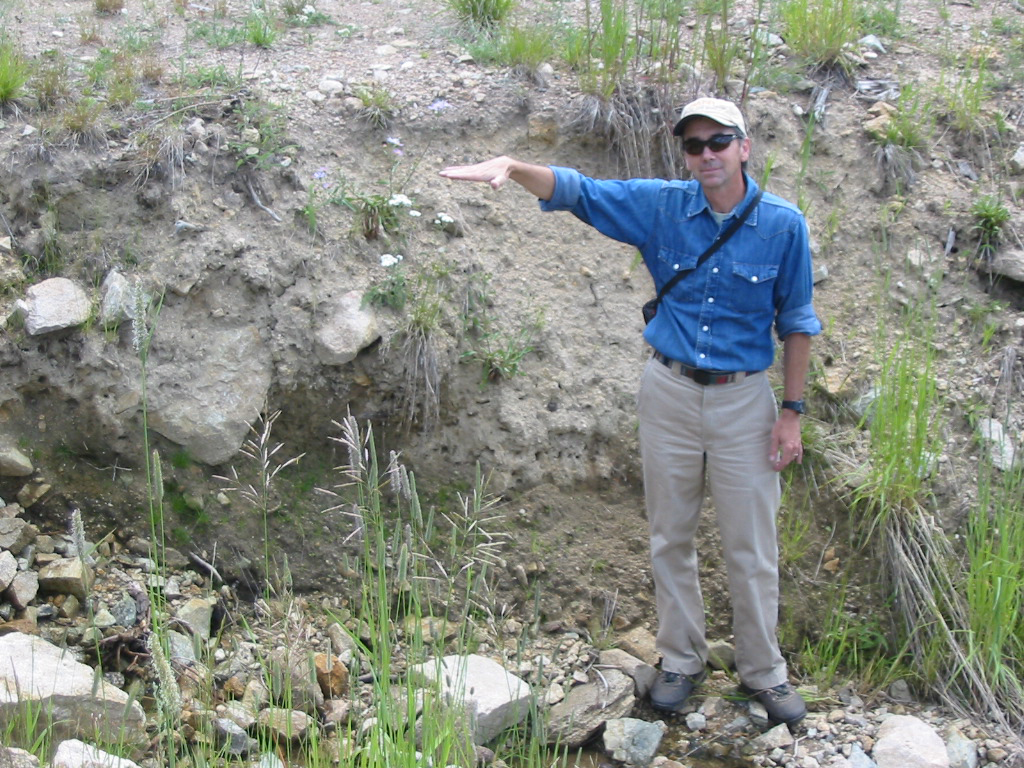Darby Project Brings the End of the Road
 Ed Snook, a hydrologist for the Bitterroot National Forest, demonstrates just how much of the road has washed away in one area where road restoration and decommissioning is set to begin. (Photo by Ed Snook)
Ed Snook, a hydrologist for the Bitterroot National Forest, demonstrates just how much of the road has washed away in one area where road restoration and decommissioning is set to begin. (Photo by Ed Snook)
From an aerial view, the landscape around the two watersheds looks scarred.
Dirt roads built by timber companies slash across the South Fork Sleeping Child and Rye Creek drainage areas, leaving more than 22,000 acres riddled with patches of exposed soil. The lands, located in the Sapphire Mountains east of Darby, were acquired by the Forest Service in 2005. Almost 10 years later, Ed Snook, a Bitterroot National Forest hydrologist, is in the final stages of readying a project to remove more than 60 miles of those roads and to restore the rest.
The Darby decommissioning project is part of a nationwide trend among U.S. Forest Service districts as an attempt to improve water quality. In 2012, nearly twice as many road miles were taken out in Montana than the previous year. The trend can be seen locally in the Bitterroot National Forest, which decommissioned 8.3 miles of road in 2011, 10 miles in 2012 and 12 miles in 2013. If the Darby Lumber Lands project is approved, local numbers will continue to climb.
Many decommissioning projects started in 2008, with the Forest Service Legacy Roads and Trail Remediation program, which suggests: “Roads that were built near streams or wetlands, or on sensitive soils or steep slopes, often need to be relocated or obliterated.”
A year later, U.S. Secretary of Agriculture Tom Vilsack made watershed health a national priority, stating in his 2009 vision speech, “Restoration means managing forest lands first and foremost to protect our water resources.”
Finally, in February 2012, Forest Service Chief Tom Tidwell issued his own report calling for action. “Increasing the pace of restoration of the nation’s forests is critically needed to address a variety of threats, including fire, climate change, the bark beetle infestation and others – to the health of our forest ecosystems, watersheds and forest-dependent communities,” he wrote.
The pressure from Tidwell’s report has been felt locally in the Darby Ranger District. “There has been some political push regionally and statewide for us to increase the pace of restoration, and that’s kind of what the chief’s policy was proposing,” Snook said.
The roads targeted for removal in such restoration projects are those that run close to waterways, where excess soil can be blown in and washed downstream. The problem with excess sediment is that it can damage freshwater ecosystems and reduce drinking water quality.
Decommissioning a road involves several different tactics, from removing culverts and taking out ditches to adding fill-in soil and seeding, depending on location. With more grant money being funneled to such efforts, questions arise of whether the projects are actually improving watershed health.
“It depends on where they are,” said Michael LeMoine, a former fisheries biologist with the Lummi Nation and a current doctoral student at the University of Montana. While sediment input rarely factors into his current research, LeMoine keeps tabs on local water quality efforts.
For over a decade, LeMoine monitored fishery habitats in the Pacific Northwest, where sediment runoff from roads can have a major impact. He questions, however, the effect of roads in Montana, a much drier climate.
Decommissioning a road on a ridgetop does not necessarily improve water quality unless there is an intense mudslide or similar event, LeMoine explained. “And we don’t see that in Montana in the current climate and precipitation rates. Areas that are important are stream crossings or areas close to streams.”
In the first section slated for restoration in the Darby district, Snook said priority is being given to areas near threatened bull trout habitat. “Our proposal here,” Snook said, pointing to a map of Section One of the project, “is to basically take out every stream crossing.”
Like many other ranger districts, Darby’s often comes up short on funds for post-project evaluation. Snook has approached UM students and professors about monitoring the restoration efforts, set to begin next summer, in an attempt to understand whether decommissioning projects have the desired effects.
“Don’t get me wrong,” LeMoine said, “there are some systems where we should decommission. But the question is, look at the areas where we have decommissioned and are tax dollars really achieving the stated management goal?”
Shanti Johnson | University of Montana Graduate Student | School of Journalism
